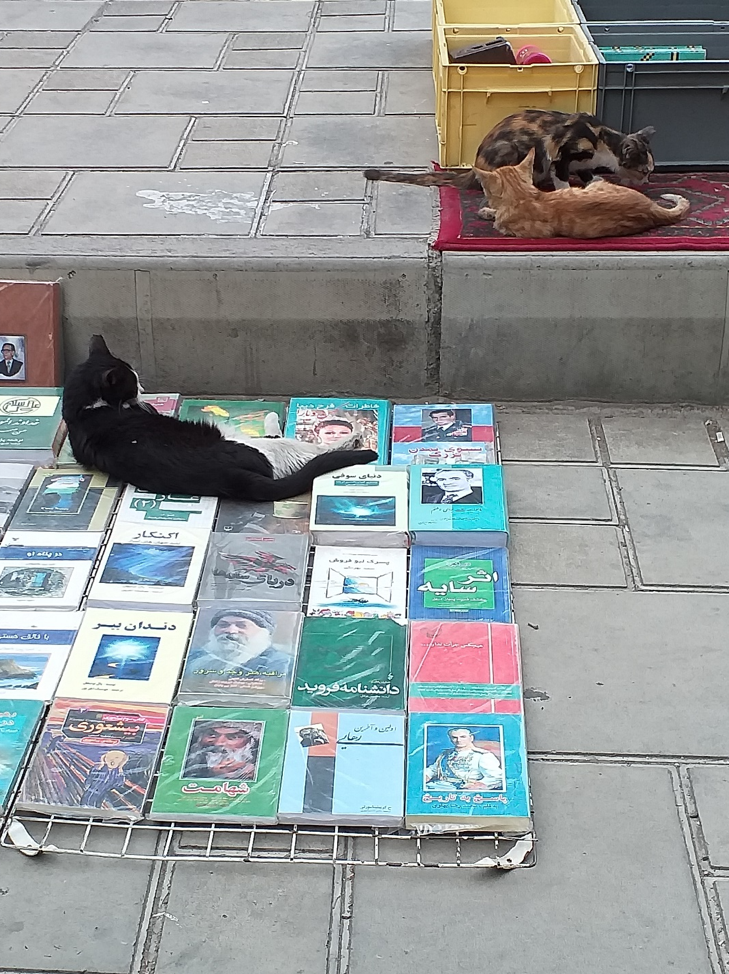Wandering through the central streets of Tehran, you will invariably come across the ubiquitous street booksellers and their stalls. As you approach the city center, particularly along Enqelab Street (Khiaban-e Enghelab) near the University of Tehran, their numbers multiply. Enqelab Street carries heavy memories of some heated political and historical moments in contemporary Iran. In quieter times, however, it is the hub for street booksellers, offering a vast array of reading materials. The variety of books available is astounding, ranging from officially licensed publications to censored, prohibited, and underground books, which are copied and distributed secretly. In some instances, you might find books that are readily available in the neighboring bookstores, but there is a stark difference between them. Street books possess an aura, making them special and different from the books of the bookstores, which are primarily cultural commodities. As soon as they are on the streets, especially on Enghelab Street, they become political.
Interestingly, even authors whose books have not been censored might spot their works among these street books. This implies their popularity and higher status among more engaged readers. Street booksellers discern the preferences of everyday readers and offer insight into the public’s literary tastes.
Street books possess an aura, making them special and different from the books of the bookstores, which are primarily cultural commodities. As soon as they are on the streets, especially on Enghelab Street, they become political.
The authorities continually lament the absence of legal measures against this phenomenon. However, given the fragile economic situation and widespread unemployment, cracking down on street booksellers, like other street vendors, is politically perilous. Even if these vendors are temporarily rounded up, they tend to return to the streets after a while. Their presence reveals that the conventional publishing industry, which, apart from rising prices, is heavily constrained by censorship, fails to meet the readers’ demands. Consequently, readers turn to these vendors to satisfy their needs.
In recent times, however, the profession of street bookselling has not remained untarnished by corruption. A “book mafia” has emerged, systematically undermining street booksellers by engaging in large-scale book duplication, further jeopardizing the booksellers’ livelihoods. This poses a threat to both bookstores and street booksellers, who are already challenged by the escalation of living costs, which, in turn, forces people to allocate their funds to more basic needs.
The economic turmoil has led to the closure of numerous significant bookstores. Yet, this has not resulted in the decline of street booksellers. On the contrary, despite the unprecedented inflation and the rising cost of living in Iran, people continue to read books, though probably much less than in the past. While bookstore customers primarily consist of middle-class readers, including scholars, academics, and intellectuals, street booksellers cater to the needs of the less privileged segments of society. As a result, in tandem with the escalation of socio-political hardships, the population of street book vendors has grown. This underlines the worsening economic conditions, forcing people to turn to street vending to make a living.
A Window to Collective Mentality
In Iran, street books possess a political aura. In the revolutionary days of the late 1970s, ‘White Cover’ (jeld sefeed) books were in high demand and discreetly distributed near Revolution Square. These books earned their name because they were forbidden and thus lacked titles and the author’s name. Their value, however, was equally connected to their prohibition. Many of them at the time were leftist books or manifestos of the underground guerilla organisations (see Sohrabi 2016).
Street books still hold political value despite not being directly political in themselves. These days, leftist books are not popular on the streets, and the situation has changed dramatically due to the unpopularity of leftist ideas. They have gradually been replaced with a mixture of psychology books, the history of Islam and Iran, popular novels, love stories, poetry, spirituality, mysticism, and more. Nevertheless, the political implication of street bookselling is still present. The books offered by street sellers possess a quality distinct from those in regular bookstores. While books sold in bookstores are essentially cultural commodities, a book on a street vendor’s stall carries an added political significance. Street-sold books are the symbols of political dissent.
These days, leftist books are not popular on the streets, and the situation has changed dramatically due to the unpopularity of leftist ideas. They have gradually been replaced with a mixture of psychology books, the history of Islam and Iran, popular novels, love stories, poetry, spirituality, mysticism, and more. Nevertheless, the political implication of street bookselling is still present.
Despite the multiplication of book in electronic format (PDF) that can easily be shared on media, street books continue to hold a unique and vital role in the political and cultural landscape. They preserve this status as they provide a distinct channel for conveying political ideas and underlying social attitudes that might not be effectively communicated through other means, such as academic institutions or social media, due to censorship. While it is impossible to generalise current social aspirations in Iran solely based on them, they reveal to some extent what Iranians are dreaming about.
Apart from being part of the informal economy, street books also provide a sociological insight to understanding society. Street booksellers foster mutual engagement between the audience and the book, while official bookstores typically operate as one-way channels for knowledge dissemination. For example, the book Aisha After the Prophet by Kurt Frischler, translated into Farsi by Zabihullah Mansouri, is among the popular street books. This popularity comes not only from its content, which is about the Prophet’s beloved wife but also from the translator Zabihollah Mansouri, who is extremely popular for his art of storytelling. In recent years, books by the last Shah of Iran, Mohammad Reza Pahlavi, including Answer to History and Toward a Great Civilization, and Memoirs of Farah Diba, the former Queen of Iran, have become very popular. This implies not only the popular curiosity about the pre-revolutionary time but also a paradigm shift in popular political imagination.
Street Politics and Street Margins Politics
Field research hinges on the relationship between the researcher and the field, including the individuals and objects that shape it. However, to comprehend how street books represent political dissent, the researcher must be aware of the historical implications, continuities and discontinuities of a seemingly mundane social phenomenon. The case of street books shows the significance of this phenomenon’s background, without which it could appear as just another informal economic activity. As we have seen in the previous section, street books transcend their role as mere commodities in an informal economy; they are political objects. As Kusha Sefat notes, objects do not merely facilitate human action but can expand or create subjects themselves. Objects have agency and influence individuals (Sefat 2023: 2).
For many researchers, politics in the Global South and countries such as Iran is encapsulated in street protests. However, street margins politics are often equally important, though, for the most part, they remain hidden from quick and temporary research involvements by researchers who do not spend enough time in the field or lack profound engagement. In the Iranian context, politics is not necessarily represented by street demonstrations or party politics. Politics can also be mediated and represented by books. Street books are windows through which the political journey of a nation, as well as the nation’s hopes, despairs, aspirations, and disappointments, become apparent.
(…) to comprehend how street books represent political dissent, the researcher must be aware of the historical implications, continuities and discontinuities of a seemingly mundane social phenomenon. The case of street books shows the significance of this phenomenon’s background, without which it could appear as just another informal economic activity.
The case of street books in Iran is also indicative of how the complexities of everyday life in the Global South require deep and long engagement. What we call field research is the inquiry of people’s lives, as they are lived, experienced, reproduced and interpreted by the people, interacting with the long durée of historical and political change. Lifeworld is composed of multi-layered experiences, narratives, and performances that cannot be reduced to data depots and cannot be determined and represented by disengaged trips and narratives of anthropological research within a short timeframe. Thus, decolonising encompasses not only giving voice to the subaltern, but also paying attention to hidden and invisible aspects. A strictly objective approach may lead to superficial, truncated, and inadequate engagement, potentially resulting in interpretative “misunderstandings.” As Heath Cabot contends, “the business of anthropology” would ignore the roots of the global refugee crisis by focusing on national borders and ignoring the colonial history behind it (Cabot, 2019). The case of street books demonstrates that a very dynamic set of ethnographic fieldwork practices is required. The dynamism embedded in fieldwork goes beyond the Cartesian research methods, especially when particular aspects such as social and political imaginaries are to be captured. Decolonising involves recognising the limits, engaging in deep historical reading before engaging in research, opening dialogues with researchers on the ground in ways that are not extractivist, and where the latter are cited, recognised, and remunerated equally.
For many researchers, long-term and uninterrupted engagement in the field, though being an ideal type, is not possible, and uninterrupted fieldwork engagement, in many ways, contradict with the realities of the field. Considering these limitations, Gökçe Günel and Chika Watanabe developed the concept of “patchwork ethnography” as a method that shows how ethnographers’ personal life impact the process of knowledge production and how fieldwork intersects personal and professional responsibilities (Günel and Watanabe, 2023; see also Günel et al., 2020). Drawing on the discipline’s strengths, patchwork ethnography exposes anthropology’s potential to further expand what theory means and who can be considered a theorist. A similar attitude could be applied to field research in the Global South. The best method would be to “highlight that some of the justifications for our research design might be based not on the research topic or subjects, but on the personal circumstances of intersecting responsibilities and choices” (ibid., p. 133). This approach advocates for writing “about” rather than “against” the disruptions that might characterize anthropological research projects. However, there seems to be a limitation to this approach. Centering on reflexivity, decolonising can provide the tools to rethink not only the very research practices but also the ways in which social sciences are applied in the contexts of the Global South.
Acknowledgement
This publication is part of the ERC StG 2019 TAKHAYYUL Project (853230). I would like to thank the TAKHAYYUL team for ongoing discussions on the issues of decolonisation, nativeness, engagement, and commitment. I also would like to thank Ioanna Manoussaki-Adamopoulou for the amazing and insightful review of the previous version of this piece and the Allegra Lab team, particularly Till Mostowlansky and Faduma Abukar Mursal, for their help and patience in getting the roundtable published.
Photo credit: The stall of a street book seller in downtown Tehran, Summer 2021 (Photo by the author).
References
Thomas, N. (1998). “Forward” to Alfred Gell, Art and agency: An anthropological theory. Oxford and New York: Oxford University Press.
Cabot, H. (2019). “The business of anthropology and the European refugee regime.” American ethnologist. Vol. 46, No. 3, pp. 261–275.
Sefat, K. (2023). Revolution of things: The Islamism and post-Islamism of objects in Tehran. Princeton and Oxford: Princeton University Press.
Sohrabi, N. (2016). “Books as revolutionary objects in Iran.” At: https://ageofrevolutions.com/2016/04/04/books-as-revolutionary-objects-in-iran/
Günel, G. et al. (2020). “A Manifesto for Patchwork Ethnography.” Member Voices, Fieldsights, June 9, 2020.
Jobson, R.C. (2020). “Year in review: The case for letting anthropology burn: Sociocultural anthropology in 2019.” American anthropologist. Vol. 122. No. 2, pp. 259–271.
Abstract: Focusing on street books in Tehran as political objects and windows into the collective imagination, this paper problematises the dominant notion of the field by highlighting the invisible aspects of field research in the Global South. Through an exploration of the distinctive phenomenon of street books in Tehran, it illustrates how politics is manifested in these books as political objects in modern Iran. It argues that politics in the Global South is not merely exemplified by street protests; street margin politics can be equally impactful, revealing collective ideals, as well as people’s frustrations, reflections, hopes, aspirations, and despair.





